Overview
A Manufacturing Order (MO) is a work order that is created for a Bills of Material (BOM), which is created in either SalesPad or Dynamics GP’s manufacturing modules.
Security
In the SalesPad Security Editor (Modules > Security Editor), search for “Manufacturing Order” to enable the MO functionality.
- Manufacturing Order Entry
- Can Edit – True/False. Determines if a user has permission to edit MOs.
- On Load Script – Script that executes before a MO is loaded.
- Pre Save Script – Script that executes before a MO is saved.
- Manufacturing Order Properties
- Manufacturing Order Search
- Manufacturing Order User Fields
- Allow Layout Customization – True/False. Determines if a user has permission to edit the User Field layout.
- Read Only – True/False. Determines is a user has permission to edit User Fields.
- Sales Document Manufacturing Orders
- Can Remove Link – Determines if a user has permission to remove a SOPtoMOP link from a sales document.
- Manufacturing Order Sales Links
- Can Remove Link – Determines if a user has permission to remove a SOPtoMOP link from a MO.
- Create Manufacturing Order
- Auto Save – True/False. If “True,” when creating a MO from a sales line, the MO will be created and saved without opening a tab displaying the MO. If “False,” for each BOM that needs a MO on the Sales Document, a separate MO tab will be opened, and will need to be saved.
- Default BOM Type to Create MO – Select the default BOM Type to be used when creating the MO, for cases where there are multiple BOMs for the same item number.
- Pre Save Script – Pre Save Script that executes before the MO is saved, when creating an MO, with Auto Save set to “True.”
- Attach Sales Line To Manufacturing Order
- Sales Line Create Manufacturing Order
- Auto Save – True/False. If “True,” when creating a MO from a sales line, the MO will be created and saved without opening a tab displaying the MO. If “False,” for each BOM that needs a MO on the Sales Document, a separate MO tab will be opened, and will need to be saved.
- Default BOM Type to Create MO – Select the default BOM Type to be used when creating the MO, for cases where there are multiple BOMs for the same item number.
- Pre Save Script – Pre Save Script that executes before the MO is saved, when creating an MO, with Auto Save set to “True.”
- Attach Manufacturing Order to Sales Line
- Manufacturing Order Report
Manufacturing Order Search Screen
The MO Search is found on the ribbon menu across the top of the SalesPad window, on the Manufacturing tab.
Here, the user can search for existing MOs by any part of a keyword in the MO number, or by the BOM number for which the MO was created.

Clicking on any of the MOs will open the MO Entry Screen.

Manufacturing Order Entry
MO Number: If the user has not already specified a number, MO Numbers are automatically assigned by SalesPad on saving the MO, with each subsequent MO Number increasing, as new MOs are created.
Item Number: This is the BOM number that will be used to create the MO. Clicking the ellipses will open a search that allows users to search for a BOM.
BOM Name: If required, this is the BOM name of the BOM that will be used to create the MO. Clicking the ellipses will open a search that allows users to search for a BOM by name.
BOM Revision: This field displays the revision level of the BOM.
Routing Name: This is the routing that will be used when scheduling the MO. Clicking the ellipses will open a search that allows users to search for a routing by name.
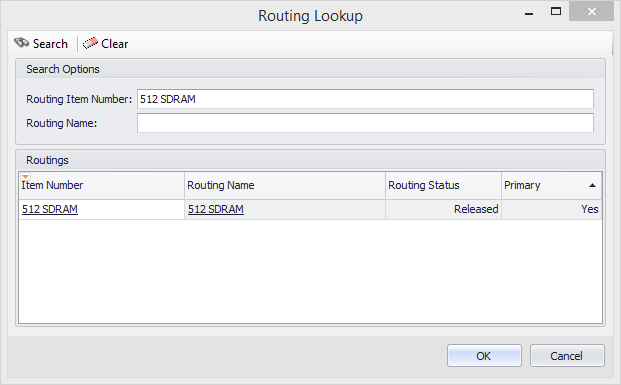
Draw Site: This field allows the user to set the site from which materials will be allocated for manufacturing.
Post Site: This field allows the user to set the site for which the finished goods will be placed into inventory.
Scheduling Pref.: This field allows the user to set the scheduling preference for the MO. A scheduling preference decides the end item shrink percentages, scheduling options, and closing options.
Scheduling Method: This field allows the user to set the scheduling method for the MO.
- Forward Infinite: Assumes that you’ll supply a start date for the manufacturing order and that you have unlimited resources to complete the work.
- Backward Infinite: Assumes that you’ll supply a due date for the manufacturing order and that you have unlimited resources to complete the work.
Start Quantity: Start quantity cannot be less than the end quantity. The start quantity can be manually entered, or, when entering the end quantity, start quantity can be calculated, taking finished item shrink into account.
End Quantity: This is the quantity to be produced by the MO. The default for this value is defaulted from the corresponding item engineering data.
Start Date: This field is available only if you’ve selected “Forward Infinite” scheduling method.
End Date: Due date for the MO. This can be manually entered, assigned by security, or calculated.
Forecast Plan: If the manufacturing order automatically was created in the “Master Production Scheduling” module as a result of a forecast plan, the plan name will be displayed.
Actual Demand: Displays the quantity being built for this MO that are linked to sales documents.
Create Manufacturing Order/Sales Line Manufacturing Order
There are two plugins on a sales document that allow sales lines to generate the creation of manufacturing orders.
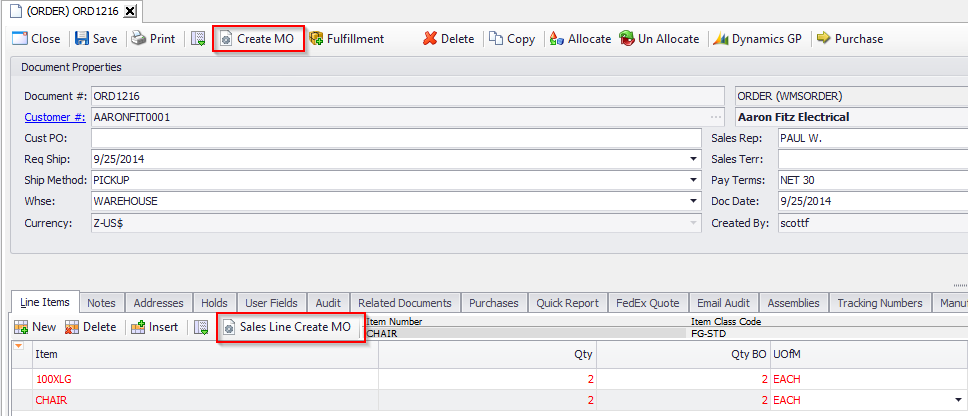
For a sales line to be considered when generating MOs, they must fulfill the following MO Linking Requirements:
- The sales line must have quantity backordered.
- The item on the sales line must have a Made to Order fulfillment method.
- There cannot be another link to an MO on the sales line already.
- There must be a Manufacturing BOM setup for that item.
The Create MO plugin on the document header will look through all sales lines, and generate MOs for the sales lines that fulfill the MO Linking Requirements.
The Sales Line Create MO plugin will create a single MO for the sales line that is focused, if it fulfills the MO Linking Requirements.
If the Security Auto Save for the corresponding plugin is set to True, then the MO will be created silently. If set to False, the MO Entry screen will open for each MO that was created from running the plugin. These MOs can be modified, but then must be saved for them to be linked back to the sales line they were generated from.

If there is more than one type of BOM for the item on the sales line, you can specify the default type to use with the Security Default BOM Type to Create MO.
If you choose to leave this security blank, in the case of multiple BOM types for the same item, there will be a prompt to select the BOM type to use on the MO.
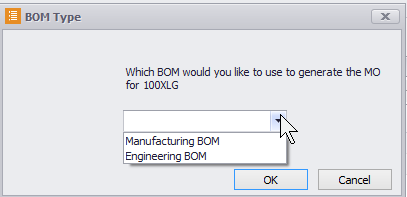
Once the sales line is linked to an MO, a blue indicator will show in the far left cell of the sales line. Also, there will be a link on the Manufacturing Orders tab.


These links can be removed from the Manufacturing Orders tab on the sales document, or on the MO Sales Links tab.

Manufacturing SOP to MOP Links
Sales lines that fulfill the MO Linking Requirements can be manually linked to MOs from the sales document with the Attach Sales Line to MO plugin.
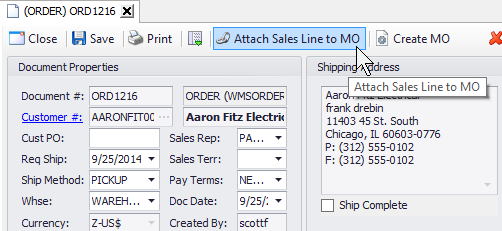
Lines that are linked will be indicated with a link indicator icon on the left pane. From this screen, links can be created by double-clicking the MO to link the sales line to, or broken with the Break Link button.
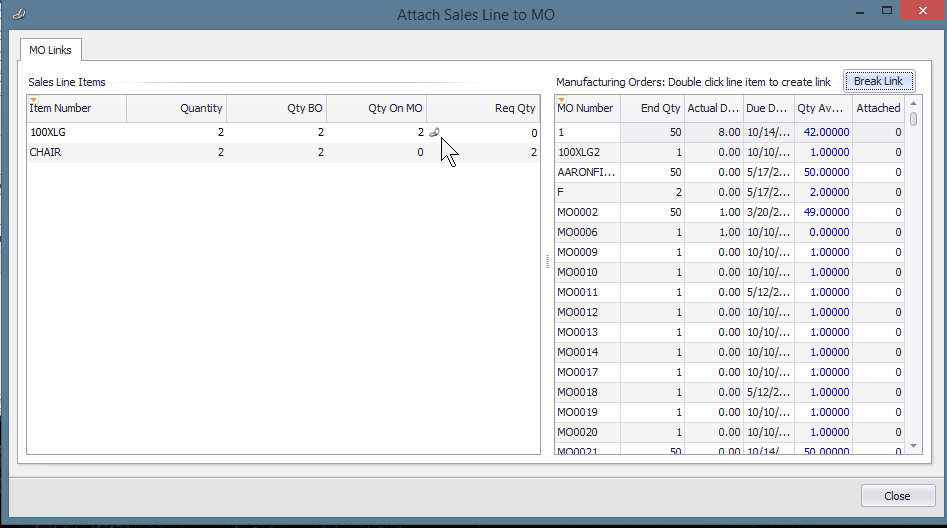
Similarly, with the Attach MO to Sales Line plugin on the MO Entry screen, MOs can be linked to sales lines.
The actual demand on the MO reflects the total linked sales line quantity against that MO. If you attempt to create a link to a sales line, but that MO does not have enough quantity available to cover the sales line, you will be prompted to choose to increase the MO quantity to cover the necessary amount on the sales line.
You can also increase the quantity on the MO by the quantity needed on the sales line.
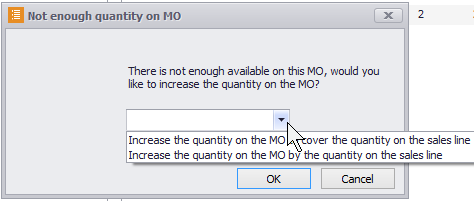
Manufacturing Order Cost Calculations
When an MO is saved in SalesPad, the Labor Costs, Machine Costs, and Material Costs for the MO are calculated automatically. These calculations are based on the item that you are building, the end quantity of the MO, and the routing used on the MO.
If we are accounting for Raw Material Shrinkage, we will refer to the Raw Material Scrap Calculation of the Component Build UofM Base Qty as the Adjusted Qty.
The fields that SalesPad sums are:
- Labor Project Cost
- Labor Fixed Overhead Project Cost
- Labor Variable Overhead Project Cost
- Machine Project Cost
- Machine Fixed Overhead Project Cost
- Machine Variable Overhead Project Cost
- Materials Project Cost
- Materials Fixed Overhead Project Cost
- Materials Variable Overhead Project Cost
Calculating Labor and Machine Costs
For each of the top level components of the BOM we check the Standard Cost Maintenance (SCM) for each component, for the Labor and Machine fields. If the calculation is marked to be done on that component item, and the effective date for that cost is current, then the cost is added to the sum for the appropriate Labor or Machine field.
For each Routing Sequence in the MO Routing:
Labor
- Summed Labor Cost += Labor Code Cost * Labor Time
- Summed Labor Setup Cost += Setup Labor Code Cost * Setup Labor Time
- Summed Labor Var += Labor Var Amt * Labor Time
- Summed Labor Setup Var += Setup Var Amt * Setup Labor Time
- Summed Labor Fixed += Labor Fixed Amt * Labor Time
- Summed Labor Setup Fixed += Setup Fixed Amt * Setup Labor Time
Machine Cost
- Summed Machine Cost += Machine Cost * Machine Time
- Summed Machine Var += Machine Var Amt * Machine Time
- Summed Machine Fixed += Machine Fixed Amt * Machine Time
After calculating all these Sums for each field, for each routing sequence:
- Labor Project Cost = (Summed Labor Cost * MO End Qty) + Summed Labor Setup Cost
- Labor Fixed Overhead Project Cost = (Summed Labor Cost * MO End Qty) + Summed Labor Setup Fixed
- Labor Variable Overhead Project Cost = (Summed Labor Cost * MO End Qty) + Summed Labor Setup Var
- Machine Project Cost = Summed Machine Cost * MO End Qty
- Machine Fixed Overhead Project Cost = Summed Machine Fixed * MO End Qty
- Machine Variable Overhead Project Cost = Summed Machine Var * MO End Qty If the field is a “Material” field, we then take the following additional process:
Material Cost
Only lines that are “Periodically Valued,” that are “Bought/Made” or “Bought,” and do not have a BOM are calculated in the “Material Costing.”
Only BOM Lines that have an “Effective in Date” greater than the current date and “Effective out Date” less than the current date will be included.
For each line, we check if the component is a “Phantom BOM,” and if our “MO Scheduling Preference” accounts for the shrinkage of raw items.
We then check the “Standard Item Costs” for each component, for each of the “Material” fields. If the calculation is marked to be done on that component item, and the effective date for that cost is current, then the appropriate “Standard Item Cost” is used in the calculation. Otherwise, either the “Standard Cost” or “Current Cost” for the item is used, depending on the “Valuation” of the component.
If the Component is Not a “Phantom BOM”:
- If we are accounting for “Raw Material Shrinkage”:
- Material Cost With Raw Material Issue Scrap
- If we are not accounting for “Raw Material Shrinkage”:
- Material Cost No Scrap
If the Component Is a “Phantom BOM”:
- If we are accounting for “Raw Material Shrinkage”:
- Material Cost With Raw Material Issue Scrap, Phantom Children
- If we are not accounting for “Raw Material Shrinkage”:
- Material Cost No Scrap, Phantom Children
Material Cost No Scrap
- Our Adjusted Qty = Component Build UofM Base Qty
- Material Calculation
Material Cost with Raw Material Issue Scrap
- Adjusted Qty = Material Scrap Qty Scrap Calculation
- Material Calculation.
Material Cost No Scrap, Phantom Children
- For each component of the Phantom Sub BOM
- Adjusted Qty = Phantom Component Build UofM Base Qty
- Material Calculation.
Material Cost with Raw Material Issue Scrap, Phantom Children
- For each component of the Phantom Sub BOM
- Adjusted Qty = Material Scrap Qty Scrap Calculation
- Material Calculation.
Material Calculation
- Material Cost = (SCM Material Cost * (Adjusted Qty * MO End Qty) + component Fixed UofM Qty)
- Material Var = (SCM Material Var Overhead * (Adjusted Qty * MO End Qty) + component Fixed UofM Qty)
- Material Fixed = (SCM Material Fixed Overhead * (Adjusted Qty * MO End Qty) + component Fixed UofM Qty)
Material Scrap Qty Calculation
- If the item has 0 qty decimal places:
- Adjusted Qty = Ceiling(Component Build UofM Base Qty /(1-(Shrink percent/100))) * MO End Qty
- If greater than 0 qty decimal places:
- Adjusted Qty = RoundDown(Component Build UofM Base Qty /(1-(Shrink percent/100))) * MO End Qty
Example
The BOM for the item “Computer” has the following components, and the costing in the following table.

| Component |
Standard Item Material Cost |
Fixed Overhead Cost |
Var Overhead Cost |
| MOTHERBOARD |
200.13 |
0 |
0 |
| CPU |
200 |
1 |
3 |
| SOLDER |
.01 |
0 |
0 |
| 3-J2094A |
55 |
0 |
0 |
| HD-60 |
53 |
0 |
0 |
| KPA100 |
6 |
0 |
0 |
| M2100 |
74 |
0 |
0 |
An MO with an End Qty of 1 will have:
Material Project Cost: $388.13, Fixed Overhead: $2.00, Variable Overhead Cost: $6.00
SalesPad Support
Comments